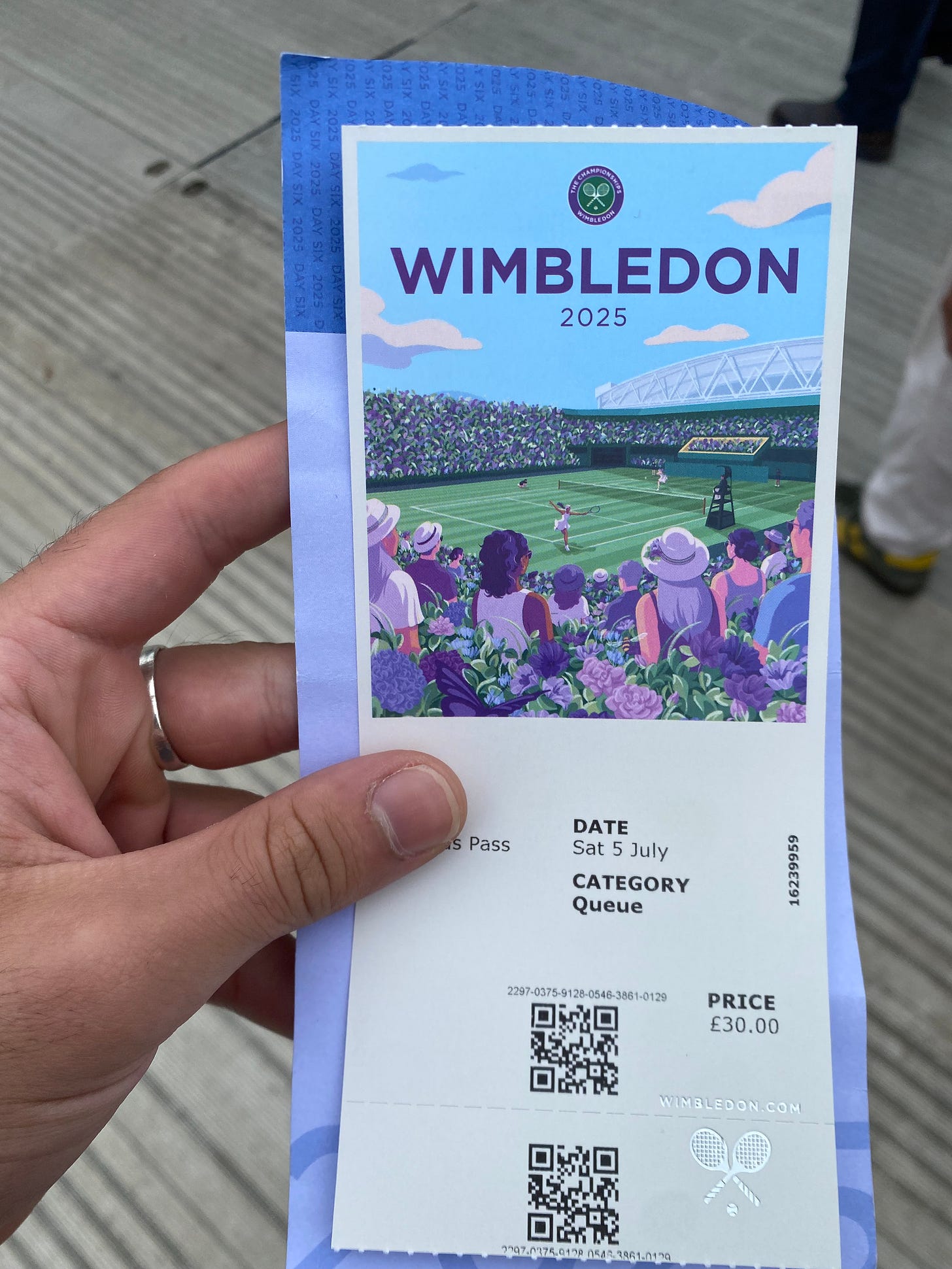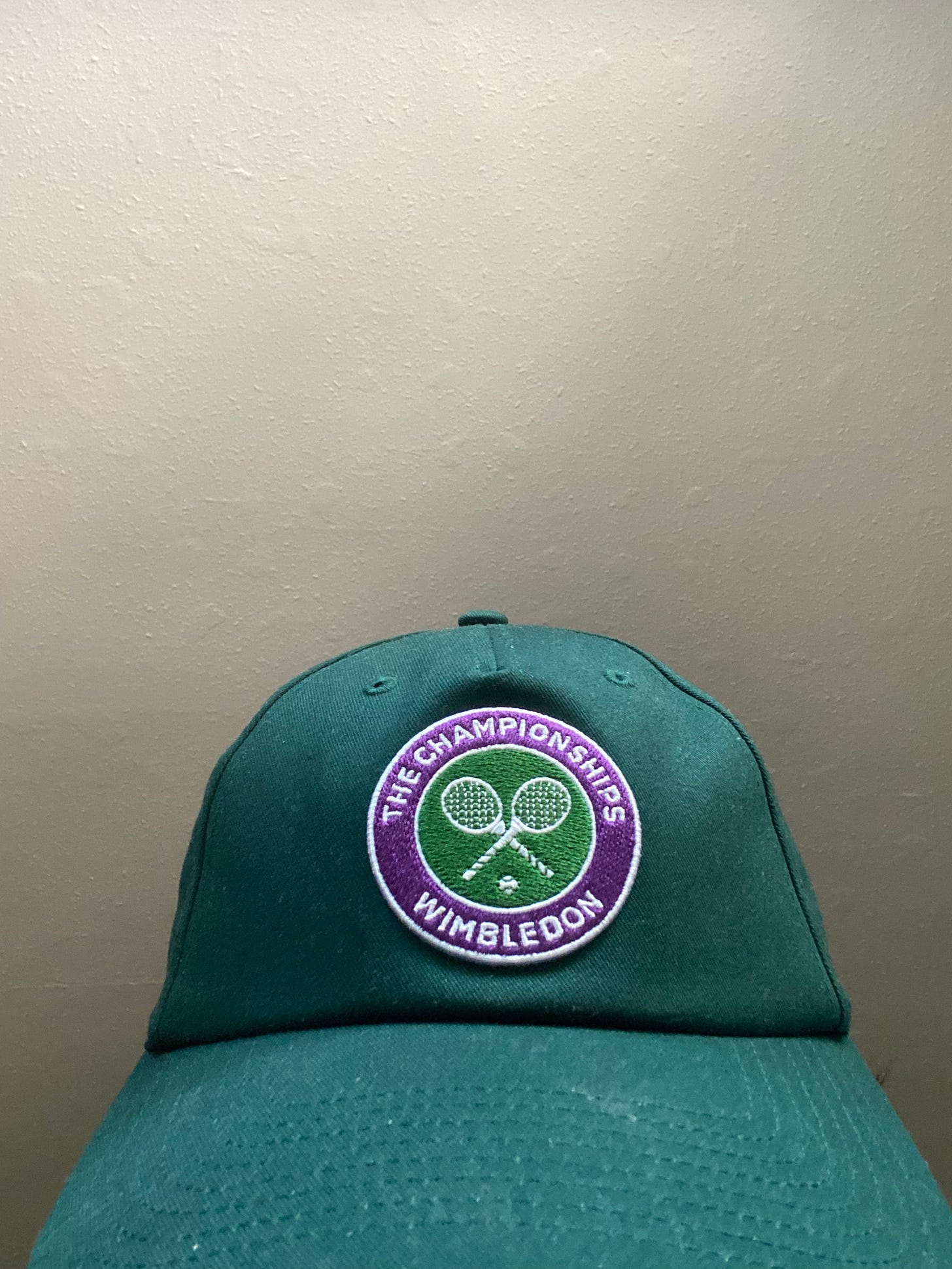The Queue
It’s 5:37 a.m. I’m dazed, confused, and in the queue for one of the most iconic sporting events in the world. It’s cold, and a steward asks my friend how many people we are.
“Six,” he replies. We’re handed our queue cards: 8374. We are in for the long haul.
I used to play Tennis twice a week for years, but when I moved for university, the interest kind of fizzled out while so many new things fizzled in.
Queue (great pun, I know) my friend’s birthday. He’s a big tennis fan and, in contrast to me, kept playing after moving to uni. His suggestion? Wimbledon.
If you’re unfamiliar with how ordinary people (those who don’t have hundreds of pounds to spare for Centre Court tickets) get in, let me explain.
Wimbledon has a tradition where you can buy ground pass tickets for £30, giving you access to the grounds and to all courts except Centre Court and Court No. 1.
Especially earlier in the tournament, this means you can watch some of the best tennis players in the world play on random outer courts. The catch? Everyone has the same idea. According to BBC, over 10,000 people queue for these tickets–and even more, when we went. So, let’s go through it. How do you get into Wimbledon?
The queue at 5:37 am:
We woke up at 4:30 a.m., got an Uber at 5, and arrived at 5:30. When we got to the gate, my friend and his girlfriend were surprised.
“Last year, not that many people were here around that time.”
Indeed, there were a lot of people.
We walked onto a big field where thousands were already waiting, passing tents and people on picnic blankets having a good time. As an honorary steward would tell us later, 3,000 people had already camped out the night before. It was clear people were ready to spend serious time here.
As we shuffled to get our place in the queue, a steward told us to stay behind a white line they had drawn, and we sat down. Picnic blankets and jackets were unpacked (even though it was July, the day had been quite cool), and as I was already wondering how this would all go, three stewards came up and gave us our cards with the numbers of our places in the queue. As already mentioned, we were number 8374.
The Luxury of Waiting
I was shocked. How were so many people ahead of us? And how was it that so many people had such a big interest in queuing? Mind you, the grounds only open at 10 a.m.
But then I experienced it myself. Sitting on a picnic blanket, surrounded by people you share a self-imposed fate with, talking with your friends, or even just lying back down reading a book—it’s all weirdly relaxing. People were playing badminton and football, drinking, and having fun.
Many people will say that going to Wimbledon is a waste of time, as if you don’t get there by 3 a.m., you’ll only be let in around 2 p.m. And that’s true—we waited 8 hours to be let in. But that’s what makes the tournament so unique. The queue, in a weird way, is a major part of the event.
When else do you take an entire Saturday morning to hang out with your friends, play cards, chat about nothing? Waiting in that queue actually felt like we were gaining time. Time you’re normally expected to be productive was now time that you can spend doing nothing—with a justifiable excuse. Queuing for Wimbledon gives you a socially acceptable reason to pause. We seem to need a goal in order to permit ourselves to rest. Something I’ve written about before, in an article about smoking, which you can read here.
Because we normally focus on productivity, eight hours of waiting feels obscene, almost decadent. Wimbledon provides the perfect excuse. It’s iconic (arguably the most iconic of the Grand Slams), and it’s low-stakes. You’re not on edge; you can chat during matches, eat, and wander. It’s something worth seeing, but it doesn’t demand your total focus. It’s leisure with structure.
While we waited, there were a couple of quick rain showers, which, for the seasoned Wimbledon viewer, was something to be happy about.
“If it rains, they stop playing, and we might get to watch more tennis,” my friend said.
The fact that we didn’t have an umbrella at first didn’t faze us. We just used the blankets as cover. The eight hours we spent waiting could’ve been two, for all we knew.
Once the queue started moving, there was still a lot of waiting to do. Around 1 p.m., they let us into the premises—not the courts yet, just the long path toward them. They checked our bags for explosives (with adorable sniffing dogs), and then the queue moved very slowly. It took us an hour to walk 800 metres to the ticket office.
Once there, we bought our tickets (you need the Wimbledon app for this, by the way) and then, £30 lighter, we were in. Not only did it feel like an achievement for our time, but in a world where watching pro sports is becoming a luxury, £30 to watch some of the top players in the world can be considered a steal.
The Aesthetics of Wimbledon
Inside, we first explored the grounds and then, per our friend’s suggestion, queued again for Court 18. Another queue? I wanted to watch some tennis!
So, my friends stayed, and my girlfriend and I went to see people play from the sidelines. Watching some of the doubles, hearing the quaint claps, seeing everyone in Ralph Lauren, and the absolute silence during serves, I realised this might be another reason why Wimbledon is so popular.
In a time where aesthetics are currency, where taste is your social capital (great essay on that here), Wimbledon is something you can wear like a badge. You see people in the queue dressed in linen suits, sipping champagne from wooden picnic baskets, posing with designer sunglasses like they belong on a yacht. And yet we were all in the same queue, waiting eight hours to be let in.
Still, I get why some people see Wimbledon as a playground for posh twenty-somethings with flexible weekends and just enough money to romanticise waiting. And they’re not wrong. There’s definitely a whiff of curated middle-class leisure to the whole thing. But I also think there’s something quietly radical about 10,000 people taking a day off to do nothing but wait together.
That’s not to say it’s accessible to everyone. This whole experience is only possible for those who can take a day off work, live near London, own a smartphone, and have the cultural literacy to know how Wimbledon works.
Because Wimbledon runs on ritual. Strawberries and cream. Pimm’s. Stewards in suits. Without our friends—who’d been before—we wouldn’t even know where to queue. It’s like a festival or a pilgrimage. There’s a script to follow. Even getting to your seats is a ceremonial act.
After queuing for Court 18, we were let in one by one by a steward. A man in what looked like police cosplay showed us to our seats. They only allow one person in at a time, so sitting together was mostly luck. Once seated, you can’t leave without losing your spot, so that everyone gets a chance to sit. I’d made sure to go to the bathroom beforehand.
Sitting that close to the action, on some of the best seats in the house, you realise this is how tennis is meant to be watched.
The match we watched was a men’s singles: Cilic vs Munar.
My god, they can play. When you play tennis, there are always balls you know you can’t reach. Even if you sprint toward them, you already know in your mind it’s over. But not here. Balls were returned that I thought were impossible to get. I firmly believe the elegance of the sport does not translate on TV. You need to see it live. It’s like listening to a kid practising a Bach sonata—waiting for the inevitable wrong note or awkward rhythm—but it never comes. They just play through.
That elegance shapes the whole experience. You wouldn’t feel quite so distinguished watching a boxing match, even though those tickets can be more expensive than Centre Court. The grace, the silence, the style—it all adds to the atmosphere of the sport. To the aesthetics of it all.
Wimbledon as an example
In the end, would I recommend Wimbledon? Yes.
And I’ll go a step further: I want this kind of access to be the norm in sport. I want a cheap alternative for every event. Football, basketball, golf—they’ve all become exclusive, expensive, almost sacred. But they shouldn’t be.
Wimbledon might look like an elite institution—and in many ways, it is—but it’s also one of the few major sporting events that still makes space for normal people. It’s not fully democratic, but it’s as close as most of us will get.
That said, the real joy isn’t in the exclusivity—it’s in the time spent. Sitting on blankets with your friends, eating breakfast at sunrise, queuing in the cold, playing cards, people-watching, getting rained on. Wimbledon provides the backdrop—but the joy is in how you fill it.
So go with friends. Wake up early. Have some fun. Watch some great tennis. Get yourself a Pimm’s while looking out over Henman Hill. The vibes are immaculate, not in spite of but because you spend eight hours with your friends.
You can even buy merch significantly cheaper than in their online store. A little memento to remind yourself what it felt like when leisure didn’t feel like a luxury. Or, if you prefer, a way to lean into the aestehtics of it all and wear it like a badge. Your call.
I chose a cap.










Klingt nach ner sehr geilen Erfahrung. Und gut geschrieben bro